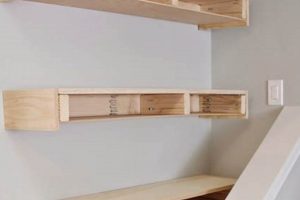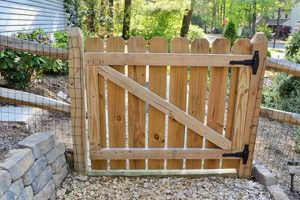Structures meticulously crafted in miniature, designed to replicate human dwellings and scaled for dolls, can be constructed by individuals rather than purchased pre-made. These miniature homes often incorporate personalized design elements and are built using a range of materials, from wood and cardboard to fabric and recycled goods. A child constructing a Victorian-style miniature house from a kit, or an adult designing a contemporary dwelling from scratch, exemplifies this activity.
The construction of miniature homes fosters creativity, problem-solving skills, and fine motor development. Engaging in this activity allows for personalized expression and provides a tangible outcome, promoting a sense of accomplishment. Historically, creating miniature houses has served as both a form of entertainment and a means of exploring architectural styles and interior design concepts. Furthermore, these miniature creations can become treasured heirlooms, passed down through generations, retaining sentimental value and representing shared experiences.
The subsequent sections will delve into various aspects of this craft, including materials selection, construction techniques, design considerations, and resources for further exploration. A comprehensive overview aims to equip individuals with the knowledge and inspiration to embark on their own miniature construction projects.
Guidance for Miniature Home Construction
The following guidance aims to assist individuals in achieving successful miniature home construction. Careful consideration of these points can contribute to a more rewarding and aesthetically pleasing outcome.
Tip 1: Material Selection: Prioritize durable and scale-appropriate materials. Balsa wood offers ease of cutting and light weight; however, its fragility necessitates careful handling. Cardboard provides a readily available and cost-effective alternative, suitable for initial prototypes and structural components. Consider acid-free varieties for longevity.
Tip 2: Precise Measurements: Adherence to precise measurements is critical for accurate scaling and seamless assembly. Employ a reliable ruler, measuring tape, and cutting tools. Double-check all dimensions before cutting any materials.
Tip 3: Structural Integrity: Ensure a solid foundation and stable walls. Reinforce joints with appropriate adhesives, such as wood glue or craft glue, depending on the materials employed. Consider incorporating internal supports to prevent warping or collapse.
Tip 4: Interior Detailing: Pay attention to interior details to enhance realism. Source miniature furniture, fixtures, and accessories that are appropriately scaled to the overall structure. Handcrafting details, such as curtains and carpets, provides opportunities for personalization.
Tip 5: Realistic Finishes: Apply realistic finishes to surfaces. Paint, stain, or wallpaper can significantly enhance the visual appeal of the structure. Consider aging techniques to create a more authentic and lived-in appearance.
Tip 6: Electrical Considerations: When incorporating electrical components, such as lighting, prioritize safety. Use low-voltage wiring and appropriate power sources. Consult with a qualified electrician if unfamiliar with electrical work.
Tip 7: Planning and Documentation: Develop a comprehensive plan before commencing construction. Sketch out designs, create material lists, and document progress. This proactive approach can minimize errors and streamline the construction process.
By adhering to these guidelines, individuals can enhance the quality, durability, and aesthetic appeal of their miniature constructions. This methodical approach contributes to a more fulfilling and successful crafting experience.
The subsequent section will explore design considerations and inspire creative approaches to miniature home construction.
1. Scale Selection
In the domain of miniature home construction, scale selection represents a foundational decision that dictates subsequent design, material acquisition, and construction methodologies. Scale, expressed as a ratio, defines the proportional relationship between the miniature representation and the full-sized original. Common scales include 1:12 (one inch representing one foot), 1:24, and 1:48. The choice of scale directly impacts the level of detail attainable, the cost of materials, and the overall footprint of the finished structure. For example, a 1:12 scale allows for greater intricacy in furniture design and more readily available miniature accessories, but requires a larger workspace and higher material expenditure compared to a 1:48 scale, which favors compact designs and economical material usage.
Furthermore, the selection of a particular scale establishes a compatibility standard. Miniature furniture, fittings, and figures are typically manufactured to conform to specific scales. Therefore, inconsistent scale application within a single miniature home project results in visual discordance and detracts from the overall realism. The prevalence of the 1:12 scale stems from its balance between manageability and visual detail; this scale offers ample space for replicating architectural features and interior design elements, while remaining accessible for hobbyists with moderate space constraints. Conversely, the 1:24 scale presents a more compact alternative, often employed in room box constructions or diorama projects where spatial efficiency is paramount. Selecting a scale that aligns with existing collections or available resources further contributes to a cohesive and cost-effective project execution.
In summary, scale selection acts as a critical parameter within miniature home construction, influencing design complexity, resource allocation, and aesthetic consistency. Diligent consideration of spatial limitations, budgetary constraints, and desired level of detail allows individuals to optimize their approach. This initial decision establishes the framework upon which the entire project rests, underscoring its fundamental importance in achieving a satisfying outcome. Failure to adequately address scale considerations can lead to dimensional inconsistencies, material incompatibility, and ultimately, a diminished final product.
2. Material Choice
The selection of appropriate materials forms a cornerstone of miniature home construction, directly impacting structural integrity, aesthetic qualities, and long-term durability. The materials employed must be suitable for the intended scale and design, considering factors such as workability, cost, and availability.
- Wood: Balsa and Basswood
Balsa wood’s lightweight nature and ease of cutting make it a popular choice for initial prototypes and structural components requiring minimal weight. Basswood offers a denser, more durable alternative suitable for load-bearing walls and intricate detailing. The selection hinges on the balance
between workability and structural strength. For example, roof trusses often benefit from the rigidity of basswood, while interior partitions can be efficiently constructed from balsa. - Cardboard and Foam Board
Cardboard, particularly archival-quality varieties, presents a cost-effective option for structural elements and room dividers. Foam board, with its smooth surface, lends itself well to creating flat, untextured walls and ceilings. These materials are easily cut and assembled, facilitating rapid prototyping and cost-effective large-scale projects. However, their susceptibility to moisture and potential for warping must be considered.
- Fabrics and Textiles
Fabrics serve as essential components for interior detailing, providing realistic textures for upholstery, curtains, and carpets. The selection of appropriate fabrics, in terms of weight, weave, and color, significantly contributes to the overall aesthetic realism of the miniature home. Fine-gauge fabrics, such as silk or linen, are often employed for delicate details, while heavier fabrics, like wool or cotton, provide durability for frequently handled items.
- Adhesives and Fasteners
Adhesive selection profoundly impacts the structural integrity and longevity of miniature homes. Wood glue provides a robust bond for wooden components, while craft glue is suitable for adhering fabrics and other lightweight materials. Cyanoacrylate adhesives (super glue) offer rapid bonding but require careful application to avoid visible residues. Mechanical fasteners, such as miniature nails and screws, enhance joint strength in critical areas.
The interplay between material selection and construction techniques determines the final outcome of the project. A thorough understanding of material properties, coupled with careful planning, ensures a robust and aesthetically pleasing miniature home. Neglecting material considerations can lead to structural failures, inaccurate scale representation, and compromised aesthetic appeal, undermining the overall project.
3. Structural Design
Structural design, within the context of miniature home construction, encompasses the strategic arrangement and interconnection of component parts to ensure stability, durability, and aesthetic appeal. This phase transcends mere replication; it necessitates an understanding of architectural principles adapted to the constraints of scale and material properties. Sound structural design forms the bedrock of any successful miniature dwelling project.
- Foundation and Base Construction
The foundation serves as the crucial starting point, distributing the weight of the structure evenly and preventing warping or collapse. Materials like plywood or dense cardboard provide a stable base. An improperly constructed foundation can lead to skewed walls, uneven floors, and overall instability. In practice, a reinforced plywood base with strategically placed supports enhances the longevity of the miniature home.
- Wall Framing and Support Systems
Wall framing provides the skeletal structure of the dwelling, determining its shape and supporting the roof. Techniques analogous to full-scale construction, such as stud placement and corner bracing, are adapted to the miniature scale. The selection of materials like balsa wood or basswood influences the load-bearing capacity of the walls. Insufficient framing can result in buckling or collapse under minimal stress.
- Roofing Techniques and Load Distribution
The roof not only protects the interior but also contributes significantly to the structural integrity. Roofing materials, ranging from miniature shingles to laser-cut panels, must be carefully installed to ensure weather resistance and proper load distribution. A poorly designed roof can compromise the entire structure’s stability, leading to water damage and eventual failure. Gabled roofs, for example, require internal support to prevent sagging.
- Joinery and Connection Methods
The methods used to join structural elements are critical for overall stability. Wood glue, craft glue, and miniature fasteners are employed to create strong and durable connections. Precise alignment and secure bonding are essential to prevent structural weaknesses. Mitered joints, dovetail joints (simplified), and reinforced corners enhance the strength of the framework. Inadequate joinery results in wobbly walls and a fragile structure.
These structural design elements interrelate to form a cohesive and stable miniature dwelling. Mastering these concepts and applying them thoughtfully transforms a collection of materials into a miniature home that is both aesthetically pleasing and structurally sound. The careful application of these principles ensures that the resulting creation withstands the test of time and remains a cherished artifact.
4. Interior Detailing
Interior detailing elevates a rudimentary miniature structure into a realistic and engaging miniature environment. The careful selection and placement of miniature objects, textures, and finishes define the character and realism of the miniature dwelling, transforming a simple shell into a convincing representation of a lived-in space.
- Miniature Furniture Selection and Placement
The choice of miniature furniture stylesVictorian, modern, or rusticestablishes the thematic direction of the interior. Precise placement optimizes spatial utilization and enhances visual flow. For instance, a carefully arranged living room set, complete with a miniature sofa, coffee table, and fireplace, creates a focal point that draws the observer into the miniature world. Inconsistent furniture styles or awkward placement detract from the overall realism.
- Textile Selection and Application
Textiles, including miniature carpets, curtains, and upholstery fabrics, introduce texture and color, softening the hard edges of the miniature architecture. Fabrics chosen should be scaled appropriately and complement the overall design aesthetic. Miniature patterned carpets, delicate lace curtains, and finely textured upholstery fabrics contribute significantly to the perceived realism of the interior. Inappropriate textile choices can create jarring visual inconsistencies.
- Lighting and Electrical Components
The integration of miniature lighting fixtureschandeliers, lamps, and sconcesadds depth and realism to the interior. Functioning lights create shadows and highlights, simulating the effects of natural light and enhancing the sense of immersion. Miniature wiring requires precision and attention to detail to ensure safe and reliable operation. A well-lit interior enhances the visibility of other details and elevates the overall aesthetic impact.
- Decorative Accessories and Personalization
Miniature accessoriesbooks, artwork, plants, and personal itemsinject personality and tell a story about the inhabitants of the miniature home. These details create a sense of realism and invite viewers to imagine life within the miniature space. Carefully curated accessories, such as miniature paintings, antique books, and handcrafted ornaments, transform a generic interior into a unique and engaging environment.
The convergence of these elements with
in the sphere of miniature home construction underscores the importance of meticulous planning and execution. Each detail, no matter how small, contributes to the overall impact of the miniature dwelling, solidifying its status as a captivating and realistic representation of a domestic space. The success of the venture is dependent on the careful consideration of each design element that leads to the final result.
5. Personalization
Personalization, in the context of miniature home construction, transcends mere aesthetic customization; it represents the infusion of individual identity and narrative into a scaled representation. This element transforms a commercially available kit or a generic design into a unique reflection of the builder’s vision and interests. Its inclusion elevates the craft from a simple construction project to a form of artistic expression.
- Architectural Modifications
Altering the basic architectural framework, such as adding dormers, bay windows, or custom extensions, provides a foundational level of personalization. These modifications shift the structure away from a standard template and towards a bespoke design. For example, a builder might replicate a childhood home’s distinctive features or incorporate architectural elements inspired by a specific historical period. These changes impart a distinctive character to the miniature dwelling.
- Custom Interior Design Schemes
Departing from pre-determined color palettes and furniture arrangements allows for the creation of personalized interior spaces. Selecting specific wallpaper patterns, flooring materials, and paint colors transforms the internal environment. Miniature furniture can be refinished or reupholstered to match a chosen design theme. This level of customization reflects the builder’s aesthetic preferences and creates a unique atmosphere within the miniature home.
- Handcrafted Accessories and Details
Creating miniature accessories, such as paintings, sculptures, and textiles, introduces a personal touch that mass-produced items cannot replicate. These handcrafted elements add a layer of authenticity and individuality to the miniature dwelling. For example, a builder might create miniature replicas of family photographs or hand-knit miniature rugs. These bespoke details enhance the emotional connection to the project.
- Narrative Integration and Storytelling
Embedding a narrative within the miniature home, through the arrangement of objects and the depiction of specific scenes, allows for the expression of personal stories and memories. This approach transforms the miniature dwelling into a three-dimensional representation of a particular moment in time or a fictional world. For example, a builder might create a miniature replica of a grandparent’s workshop or a scene from a favorite book. This narrative integration adds depth and meaning to the project.
These personalization techniques, whether architectural modifications, custom interior designs, handcrafted accessories, or narrative integrations, underscore the transformative power of individual expression in miniature home construction. The ability to inject personal identity into the creation process elevates the activity from a craft to an art form, resulting in a unique and emotionally resonant miniature world.
Frequently Asked Questions
This section addresses common inquiries and misconceptions pertaining to the creation of miniature dwellings. The information provided aims to clarify key aspects of the construction process and assist individuals in navigating potential challenges.
Question 1: What is the most appropriate scale for a first-time builder?
The 1:12 scale is generally recommended for beginners due to its balance of detail and manageability. This scale offers a wide range of readily available accessories and provides sufficient space for developing construction skills. Smaller scales, such as 1:24 or 1:48, require greater precision and specialized tools, making them less suitable for novices.
Question 2: What are the essential tools required for miniature home construction?
Essential tools include a sharp craft knife, a metal ruler, a cutting mat, wood glue, sandpaper, and a small paint brush. Additional useful tools include a miniature saw, a drill with small drill bits, and various clamps for securing components during assembly. Investing in quality tools ensures precision and improves the overall building experience.
Question 3: How can warping be prevented in miniature wood structures?
Warping can be minimized by using kiln-dried wood, sealing the wood with a primer or sealant, and ensuring proper ventilation during construction. Furthermore, constructing a sturdy foundation and incorporating internal supports can help maintain structural integrity. Avoid exposing the finished structure to excessive moisture or extreme temperature fluctuations.
Question 4: What is the best method for creating realistic miniature textures?
Realistic textures can be achieved through a variety of techniques, including dry brushing paint, using textured wallpapers, and applying modeling paste. Stippling techniques with paint sponges can create a rough surface, while fine-grit sandpaper can simulate aged wood. Experimentation with different materials and techniques is encouraged to achieve the desired effect.
Question 5: How can electrical wiring be safely incorporated into a miniature home?
Electrical wiring should be performed using low-voltage components and appropriate safety precautions. Consult with a qualified electrician if unfamiliar with electrical work. Use miniature wiring specifically designed for dollhouses and follow established wiring diagrams. Always disconnect the power source before making any adjustments or repairs.
Question 6: What are the best resources for finding miniature furniture and accessories?
Miniature furniture and accessories can be found at specialty hobby stores, online retailers specializing in dollhouse miniatures, and craft fairs. Consider repurposing existing items or crafting accessories from scratch to personalize the miniature home. Online forums and communities dedicated to dollhouse construction offer valuable information and resources.
In summary, meticulous planning, careful material selection, and a commitment to precision are crucial for success in miniature home construction. Addressing these fundamental considerations enhances the quality, durability, and aesthetic appeal of the finished product.
The following section provides insights into showcasing and preserving miniature creations.
DIY Dollhouses
The preceding discourse has illuminated diverse facets of constructing miniature residences. From fundamental aspects of scale selection and material procurement to intricate design considerations and personalization techniques, the process demands meticulous attention to detail and a commitment to precision. Effective structural design and thoughtful interior detailing are paramount to achieving a credible and aesthetically pleasing result. Successfully executed, these projects represent a tangible manifestation of creativity and skill.
The endeavor of creating “diy dollhouses” extends beyond mere replication; it embodies the preservation of architectural styles, the exploration of interior design principles, and the transmission of personal narratives. Continued engagement w
ith this craft fosters innovation and promotes the development of valuable skills. The pursuit of excellence in miniature construction stands as a testament to human ingenuity and dedication. Further exploration of advanced techniques and innovative design concepts is encouraged, ensuring the continued evolution of this enduring art form.







